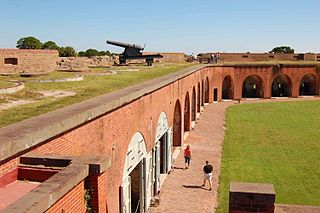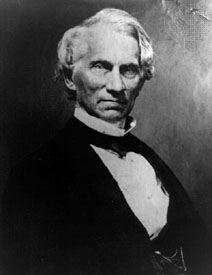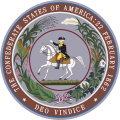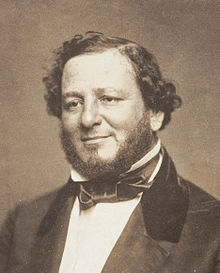
The American Civil War was a civil war in the United States between the Union and the Confederacy, which had been formed by states that had seceded from the Union. The central cause of the war was the dispute over whether slavery would be permitted to expand into the western territories, leading to more slave states, or be prevented from doing so, which many believed would place slavery on a course of ultimate extinction.

The Confederate States of America (CSA), commonly referred to as the Confederate States (C.S.), the Confederacy, or the South, was an unrecognized breakaway republic in the Southern United States that existed from February 8, 1861, to May 9, 1865. The Confederacy comprised eleven U.S. states that declared secession and warred against the United States during the American Civil War. The states are South Carolina, Mississippi, Florida, Alabama, Georgia, Louisiana, Texas, Virginia, Arkansas, Tennessee, and North Carolina.

Jefferson F. Davis was an American politician who served as the first and only president of the Confederate States from 1861 to 1865. He represented Mississippi in the United States Senate and the House of Representatives as a member of the Democratic Party before the American Civil War. He was the United States Secretary of War from 1853 to 1857.

Judah Philip Benjamin, QC was an American lawyer and politician. He was a United States senator from Louisiana, a Cabinet officer of the Confederate States and, after his escape to the United Kingdom at the end of the American Civil War, an English barrister. Benjamin was the first Jew to hold a Cabinet position in North America and the first to be elected to the United States Senate who had not renounced his faith.

Confederate Memorial Day is a holiday observed in several Southern U.S. states on various dates since the end of the American Civil War. The holiday was originally publicly presented as a day to remember the estimated 258,000 Confederate soldiers who died during the American Civil War.

The Confederate States Navy (CSN) was the naval branch of the Confederate States Armed Forces, established by an act of the Confederate States Congress on February 21, 1861. It was responsible for Confederate naval operations during the American Civil War against the United States's Union Navy.

The Confederate States Army, also called the Confederate Army or the Southern Army, was the military land force of the Confederate States of America during the American Civil War (1861–1865), fighting against the United States forces to win the independence of the Southern states and uphold and expand the institution of slavery. On February 28, 1861, the Provisional Confederate Congress established a provisional volunteer army and gave control over military operations and authority for mustering state forces and volunteers to the newly chosen Confederate president, Jefferson Davis. Davis was a graduate of the U.S. Military Academy, and colonel of a volunteer regiment during the Mexican–American War. He had also been a United States senator from Mississippi and U.S. Secretary of War under President Franklin Pierce. On March 1, 1861, on behalf of the Confederate government, Davis assumed control of the military situation at Charleston, South Carolina, where South Carolina state militia besieged Fort Sumter in Charleston harbor, held by a small U.S. Army garrison. By March 1861, the Provisional Confederate Congress expanded the provisional forces and established a more permanent Confederate States Army.

Stephen Russell Mallory was a Democratic senator from Florida from 1851 to the secession of his home state and the outbreak of the American Civil War. For much of that period, he was chairman of the Committee on Naval Affairs. It was a time of rapid naval reform, and he insisted that the ships of the U.S. Navy should be as capable as those of Britain and France, the foremost navies in the world at that time. He also wrote a bill and guided it through Congress to provide for compulsory retirement of officers who did not meet the standards of the profession.

The president of the Confederate States was the head of state and head of government of the Confederate States. The president was the chief executive of the federal government and commander-in-chief of the Confederate Army and Navy.

Franklin Buchanan was an officer in the United States Navy who became the only full admiral in the Confederate Navy during the American Civil War. He also commanded the ironclad CSS Virginia.

The Confederate States Congress was both the provisional and permanent legislative assembly of the Confederate States of America that existed from 1861 to 1865. Its actions were for the most part concerned with measures to establish a new national government for the Southern proto-state, and to prosecute a war that had to be sustained throughout the existence of the Confederacy. At first, it met as a provisional congress both in Montgomery, Alabama, and Richmond, Virginia. As was the case for the provisional Congress after it moved to Richmond, the permanent Congress met in the existing Virginia State Capitol, a building which it shared with the secessionist Virginia General Assembly.

Fort Pulaski National Monument is located on Cockspur Island between Savannah and Tybee Island, Georgia. It preserves Fort Pulaski, the place where the Union Army successfully tested rifled cannon in combat during the American Civil War in 1862, the success of which rendered brick fortifications obsolete. The fort was also used as a prisoner-of-war camp.

Christopher Gustavus Memminger was a German-born American politician and a secessionist who participated in the formation of the Confederate States government. He was the principal author of the Provisional Constitution (1861), as well as the founder of the Confederate financial system. As the first Confederate States Secretary of the Treasury, Memminger was the principal author of the economic policies of Jefferson Davis's administration.

Augustus Emmet Maxwell was an American lawyer and politician. Maxwell served in a number of political positions in the State of Florida including as one of Florida's senators to the Confederate States Congress, Florida Secretary of State, and as Chief Justice of the Florida Supreme Court.

Charles Magill Conrad was a Louisiana politician who served in the United States Senate, United States House of Representatives, and Confederate Congress. He was Secretary of War under President Millard Fillmore and, briefly, Franklin Pierce, from 1850 until 1853. Conrad also briefly acted as the United States Secretary of State following the tenure of Daniel Webster.
Military leadership in the American Civil War was vested in both the political and the military structures of the belligerent powers. The overall military leadership of the United States during the Civil War was ultimately vested in the President of the United States as constitutional commander-in-chief, and in the political heads of the military departments he appointed. Most of the major Union wartime commanders had, however, previous regular army experience. A smaller number of military leaders originated from the United States Volunteers. Some of them derived from nations other than the United States.

The Confederate States secretary of war was a member of President Jefferson Davis's cabinet during the American Civil War. The Secretary of War was head of the Confederate States Department of War. The position ended in May 1865 when the Confederacy collapsed during John C. Breckinridge's tenure of the office.

The role of Washington Territory in the American Civil War is atypical, as the territory was the most remote from the main battlefields of the conflict. The territory raised a small number of volunteers for the Union Army, who did not fight against the Confederate States Army but instead maintained defensive positions against possible foreign naval or land attacks. Although the Indian Wars in Washington were recent, there were no Indian hostilities within the area of modern Washington, unlike the rest of the western states and territories, during the Civil War. At the start of the American Civil War, modern-day Washington was part of the Washington Territory. On March 3, 1863, the Idaho Territory was formed from that territory, consisting of the entirety of modern-day Idaho, Montana, and all but southwest Wyoming, leaving the modern-day Washington as Washington Territory.

The Cabinet of the Confederate States of America, commonly called the Confederate cabinet or Cabinet of Jefferson Davis, was part of the executive branch of the federal government of the Confederate States that existed between 1861 and 1865. The members of the Cabinet were the vice president and heads of the federal executive departments.

The 1861 Confederate States House of Representatives election in Florida was held on Wednesday, November 6, 1861 to elect the two Confederate States Representatives from the state of Florida, one from each of the state's congressional districts, to represent Florida in the 1st Confederate States Congress. The election coincided with the elections of other offices, including the presidential election and various state and local elections.






















